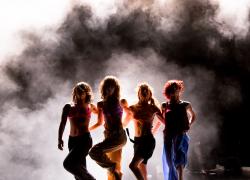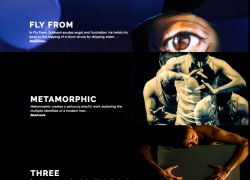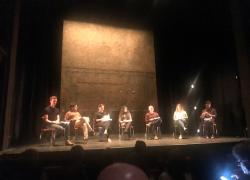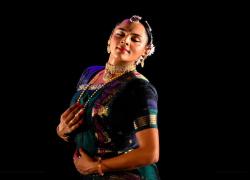Shivaangee Agrawal – Traditional Margam with a Twist
Traditional Margam with a Twist – Shivaangee Agrawal, Nehru Centre, 22nd September 2017 – Reviewed by Annapoorna Kuppuswamy
Shivaangee, a young and promising bharatanatyam dancer presented well-thought-out, beautifully choreographed, rarely-seen pieces in the traditional Margam format at the Nehru centre. Shivaangee kicked off the evening with an invocation to lord Ganesha, the elephant-headed god, with neat, crisp footwork and perfect lines.
Although her footwork was strong, it wasn’t always in sync with the music. An intriguing trend appears to have crept into nritta performance, which Shivaangee also exhibited – the compartmentalisation of the various body parts during pure footwork. When the legs move, the rest of the body appear detached with absolutely no movement. Whilst this is a difficult skill in itself, it lends a certain robotic quality to the footwork. And not looking at your hands when they move, thereby breaking the fundamental rule of where the hands go, the eyes follow, ‘yatho hastha thatho drishti’ heightens the robotic effect! The occasional breaking of the rule adds a dramatic effect but constant flaunting breaks the classical paradigm. Perhaps this is an influence from Shivaangee’s contemporary training?
The main piece of the evening was called ‘Navarasa Mohana’, an unusual piece choreographed by Rama Vaidyanathan, describing the emotions of all those present at the arena where Kamsa, the evil king, Krishna’s uncle, has challenged Krishna to a duel. Krishna enters with his weapon, the elephant tusk, and the whole arena is drawn to him, exhibiting a gamut of human emotions: Krishna’s mother full of love and concern for her son, Kamsa angry that the little boy challenges him, the cowherd boys amused by Krishna’s bravado; and finally in the battle where Krishna slays his uncle, Kamsa. Shivaangee captured the the moods and emotions effortlessly, with a good measure of theatrical techniques. The piece ended with a powerful jati to depict the final battle between Krishna and Kamsa.
Shivaangee then turned her attention to pure expression-based pieces. The first was a classic padam ‘Ithe Vida Veru Vendumo Saakshi’ – is any more proof required than this? (choreographed by Kalanidhi Mami). The hero returns after having spent a night with the other woman and the heroine points out the tell-tale marks of intimacy, says in no uncertain terms it is over between them and sends him packing. This is a beautiful piece that allows for plenty of emotional layering. Shivaangee went all out in making sure the hero got the message, full of righteous anger interspersed with sarcasm and hurt. Although this was a commendable effort, a crucial aspect of abhinaya is the ability to maintain a single ‘sthayi bhava’ or base emotion upon which all other emotions are overlaid. This pulls the narrative together. Shivaangee was switching from anger to sarcasm to hurt, with the exception of a few instances where she blended two emotions. Shivaangee must strive to develop this skill of portraying more than one emotion at the same time, but this comes with time and she surely is on the right path.
The second pure expression piece was slightly easier to handle, with little Krishna making excuses to his mother for the mess he has been making. This was an absolutely delightful piece and Shivaangee did a brilliant job running around causing trouble to all and sundry as little Krishna.
She wrapped up the evening with a thillana in the melodic scale of Vallachi, the lyrics in praise of mother goddess. This piece was originally choreographed by Rukmini Vijaykumar’s guru, Guru Narmada, and adapted by Rukmini Vijaykumar.
Overall the evening was a series of very beautifully choreographed and perfectly executed rare pieces for which Shivaangee must be commended. She has been mentored and trained by different gurus from different styles and this was very clear. The fluid, graceful steps reflected Rukmini Vijaykumar’s style, while the theatrical abhinaya had clear influences from Shane Shambhu’s technique. It is now time for Shivaangee to put her stamp on her dancing – the future for classical bharatanatyam is looking bright.
Choreographers:
"Ma Da Sa": Rukmini Vijayakumar
"Navarasa Mohana": Rama Vaidyanathan
"Ithe Vida Innum": Kalanidhi Mami
"Gummana Kareyadire": Rukmini Vijayakumar with adaptation by myself
"Vallachi Thillana": Originally Rukmini's Guru, Guru Narmada and adapted by Rukmini Vijayakumar



















